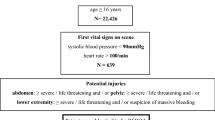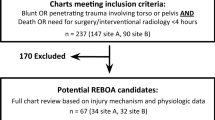Abstract
Purpose
Non-compressible torso hemorrhage is a major but potentially preventable cause of trauma-related mortality. REBOA has rapidly emerged as an adjunct for hemorrhage control. However, little is known about the proportion of trauma patients in which REBOA may be indicated. The aim of our study was to determine this proportion.
Methods
A retrospective cohort study of all adult (≥ 16 years) trauma patients treated at our facility (a university hospital and trauma referral center covering 2.5 million inhabitants) between 2012 and 2017 was performed. Potential candidates for REBOA were patients with an abdominal and/or pelvic injury and an Abbreviated Injury Scale (AIS) score of ≥ 3, who arrived in shock (defined as a systolic blood pressure, SBP ≤ 90 mmHg). Patients with potential contraindication for REBOA (prehospital cardiac arrest or thoracic vascular injury) were excluded.
Results
From a total of 7229 patients during the study years, 31 (0.4%) patients met the criteria for potential use of REBOA. In this cohort, the total mortality was 45% and the mortality within 30 days was 26%. The mean Injury Severity Score (ISS) was 46.3 and mean SBP was 72 mmHg.
Conclusions
The study suggests a potential indication for REBOA (incidence) of 2.5 per one million inhabitants per year according to the used criteria. Local REBOA guidelines may vary but a significant number of trauma centers use similar criteria. Although the total mortality within this group is high, the number of patients that theoretically may benefit from the use of REBOA is low.



Similar content being viewed by others
References
Tien HC, Spencer F, Tremblay LN, Rizoli SB, Brenneman FD. Preventable deaths from hemorrhage at a level I Canadian trauma center. J Trauma—Inj Infect Crit Care. 2007;62(1):142–6.
Eastridge BJ, Mabry RL, Seguin P, Cantrell J, Tops T, Uribe P, Mallett O, Zubko T, Oetjen-Gerdes L, Rasmussen TE, et al. Death on the battlefield (2001–2011): implications for the future of combat casualty care. J Trauma Acute Care Surg. 2012;73(6 SUPPL. 5):431–7.
Kauvar DS, Wade CE. The epidemiology and modern management of traumatic hemorrhage: US and international perspectives. Crit Care. 2005;9(SUPPL. 5):1–9.
Davis JS, Satahoo SS, Butler FK, Dermer H, Naranjo D, Julien K, Van Haren RM, Namias N, Blackbourne LH, Schulman CI. An analysis of prehospital deaths: who can we save? J Trauma Acute Care Surg. 2014;77(2):213–8.
Morrison JJ. Noncompressible torso hemorrhage. Crit Care Clin [Internet]. 2017;33(1):37–54.
Kisat M, Morrison JJ, Hashmi ZG, Efron DT, Rasmussen TE, Haider AH. Epidemiology and outcomes of non-compressible torso hemorrhage. J Surg Res [Internet]. 2013;184(1):414–21.
Hughes CW. Use of an intra-aortic balloon catheter tamponade for controlling intra-abdominal hemorrhage in man. Surgery. 1954;36(1):65–8.
Malina M, Veith F, Ivancev K, Sonesson B. Balloon occlusion of the aorta during endovascular repair of ruptured abdominal aortic aneurysm. J Endovasc Ther. 2005;12(5):556–9.
Brenner M, Teeter W, Hoehn M, Pasley J, Hu P, Yang S, Romagnoli A, Diaz J, Stein D, Scalea T. Use of resuscitative endovascular balloon occlusion of the aorta for proximal aortic control in patients with severe hemorrhage and arrest. JAMA Surg. 2018;153(2):130–5.
Rasmussen TE, Franklin CJ, Eliason JL. Resuscitative endovascular balloon occlusion of the aorta for hemorrhagic shock. JAMA Surg [Internet]. 2017;152(11):1072–3.
Rhee PM, Acosta J, Bridgeman A, Wang D, Jordan M, Rich N. Survival after emergency department thoracotomy; review of published data in the past 25 years. Am J Emerg Med. 2000;190(3):288–98.
Søreide K, Petrone P, Asensio J. Emergency thoracotomy in trauma: rationale, risks, and realities. Scand J Surg [Internet]. 2007;96(1):4–10.
Stannard A, Eliason JL, Rasmussen TE. Resuscitative endovascular balloon occlusion of the aorta. J Trauma Inj Infect Crit Care. 2011;71(6):1869–72.
Glaser J, Brenner M. The current status of REBOA in traumatic shock. Curr Surg Rep. 2017;5:23.
Brenner M, Bulger EM, Perina DG, Henry S, Kang CS, Rotondo MF, Chang MC, Weireter LJ, Coburn M, Winchell RJ, et al. Joint statement from the American college of surgeons committee on trauma (ACS COT) and the American college of emergency physicians (ACEP) regarding the clinical use of resuscitative endovascular balloon occlusion of the aorta (REBOA). Trauma Surg Acute Care Open [Internet]. 2018;3(1):e000154.
Moore LJ, Brenner M, Kozar RA, Pasley J, Wade CE, Baraniuk MS, Scalea T, Holcomb JB. Implementation of resuscitative endovascular balloon occlusion of the aorta as an alternative to resuscitative thoracotomy for noncompressible truncal hemorrhage. J Trauma Acute Care Surg. 2015;79(4):523–32.
Joseph B, Zeeshan M, Sakran JV, Hamidi M, Kulvatunyou N, Khan M, O’Keeffe T, Rhee P. Nationwide analysis of resuscitative endovascular balloon occlusion of the aorta in civilian trauma. JAMA Surg. 2019;154(6):500–8.
Swetrau Annual report 2017 [Internet]. 2017. https://rcsyd.se/swetrau/dokument. Accessed 18 Feb 2019.
Ringdal KG, Coats TJ, Lefering R, Di BS, Steen PA, Røise O, Handolin L, Lossius HM. Scandinavian journal of trauma, resuscitation and emergency medicine the Utstein template for uniform reporting of data following major trauma: a joint revision by SCANTEM, TARN, DGU-TR and RITG. Scand J Trauma Resusc Emerg Med [Internet]. 2008;16(167):1–19.
Barnard EBG, Morrison JJ, Madureira RM, Lendrum R, Fragoso-Iñiguez M, Edwards A, Lecky F, Bouamra O, Lawrence T, Jansen JO. Resuscitative endovascular balloon occlusion of the aorta (REBOA): a population based gap analysis of trauma patients in England and Wales. Emerg Med J. 2015;32(12):926–32.
Kulla M, Engelhardt M, Holsträter T, Bieler D, Lefering R, Elias K. Do we need REBOA as an adjunct to ER thoracotomy in German trauma centres ? A secondary data analysis from the TraumaRegister DGU. Anästhesiol Intensivmed. 2018;59:562–73.
Morrison JJ, Ross JD, Rasmussen TE, Midwinter MJ, Jansen JO. Resuscitative endovascular balloon occlusion of the aorta: a gap analysis of severely injured UK combat casualties. Shock. 2013;41(5):388–93.
Ribeiro Junior MAF, Feng CYD, Nguyen ATM, Rodrigues VC, Bechara GEK, De-Moura RR, Brenner M. The complications associated with resuscitative endovascular balloon occlusion of the aorta (REBOA). World J Emerg Surg. 2018;13(1):1–6.
Tsurukiri J, Akamine I, Sato T, Sakurai M, Okumura E, Moriya M, Yamanaka H, Ohta S. Resuscitative endovascular balloon occlusion of the aorta for uncontrolled haemorrahgic shock as an adjunct to haemostatic procedures in the acute care setting. Scand J Trauma Resusc Emerg Med [Internet]. 2016;24(1):13.
Davidson AJ, Russo RM, Reva VA, Brenner ML, Moore LJ, Ball C, Bulger E, Fox CJ, Dubose JJ, Moore EE, et al. The pitfalls of resuscitative endovascular balloon occlusion of the aorta: risk factors and mitigation strategies. J Trauma Acute Care Surg. 2018;84(1):192–202.
Okada Y, Narumiya H, Ishi W, Ryoji I. Lower limb ischemia caused by resuscitative balloon occlusion of aorta. Surg Case Rep [Internet]. 2016;2(1):10–3.
Doucet J, Coimbra R. REBOA: is it ready for prime time? J Vasc Bras. 2017;16(1):1–3.
Uchino H, Tamura N, Echigoya R, Ikegami T, Fukuoka T. REBOA—is it really safe? A case with massive intracranial hemorrhage possibly due to endovascular balloon occlusion of the aorta (REBOA). Am J Case Rep. 2016;1(17):810–3.
Acknowledgements
Agneta Wikman provided transfusion data from the local transfusion registry and Henrike Häbel assisted with statistical calculations.
Author information
Authors and Affiliations
Contributions
VM and CM contributed equally to the study and final manuscript. EW assisted in the revision of the manuscript.
Corresponding author
Ethics declarations
Conflicts of interest
There are no conflicts of interest to be declared and no funding was provided for the study presented.
Electronic supplementary material
Below is the link to the electronic supplementary material.
Rights and permissions
About this article
Cite this article
Mill, V., Wellme, E. & Montán, C. Trauma patients eligible for resuscitative endovascular balloon occlusion of the aorta (REBOA), a retrospective cohort study. Eur J Trauma Emerg Surg 47, 1773–1778 (2021). https://doi.org/10.1007/s00068-020-01345-w
Received:
Accepted:
Published:
Issue Date:
DOI: https://doi.org/10.1007/s00068-020-01345-w




